SDSS images may not be used for any commercial publication or other
commercial purpose except with explicit approval by the Astrophysical
Research Consortium(ARC). SDSS images may be downloaded, linked to, or
otherwise used for non-commercial purposes, provided proper credit is
given and the use cannot be construed as an endorsement of any product
or service. For more information on commercial and noncommercial usage,
please see our image use policy.
Unless otherwise noted, images should be credited to the Sloan Digital
Sky Survey.
 |
Orion Nebula
Shown above is part of one of the most imaged parts of the night sky, the Orion Nebula. Since the angular size of Orion's Nebula is so large on the sky, only a portion is shown here. Located just below "Orion's Belt" this star-forming region is dominated by four young, massive O stars (known as the Trapezium, not pictured here). The wispy blue, green gas seen above is composed mostly of hydrogen, the main element used in forming stars. The Orion Nebula is an astrophysical laboratory, providing an up-close view of the birth of stars.
|
 |
Leo A
Shown is the dwarf irregular galaxy, Leo A. This small galaxy is a neighbor of our Milky Way, at a distance of 2 million light years. Because of their low surface densities, these galaxies were not studied in great numbers until recently.Yet, there are among the most common galaxies, and becoming increasingly important for understanding how galaxies like the Milky Way form. These small galaxies are thought to be the building blocks of larger galaxies.
|
 |
Messier 34
Shown above are the stellar members of the open cluster Messier 34. Most open clusters are younger than the Sun, and thus their more massive stars are still on the main sequence. Many of the blue and purple stars in this image are more massive than the Sun. Their color indicates that these stars are hotter than the Sun and burning through their fuel more rapidly. This rapid production of energy directly contributes to their short lifetimes. These stars really do live fast and die young!
|
 |
NGC 5792
Shown is the spiral galaxy NGC 5792. While the galaxy is a pretty typical spiral, almost edge-on, with blue spiral arms and some dust features, it is neighbored by a member of our own Milky Way, a red dwarf. This star is less massive than the Sun, with a spectral type of M0. M dwarfs are the most common type of star, making up about 75% of all stars in the Milky Way. Yet, like the star in this image, most are too faint to be seen with the naked eye. This once made M dwarfs strong candidates for dark matter, but this idea has been discarded.
|
 |
Messier 90
Shown is the spiral galaxy Messier 90 and its companion IC 3583. M90 is one of the larger spiral galaxies found in the Virgo cluster. There is evidence that the two are gravitationally interacting, like many of the galaxies observed by SDSS. The color gradients seen in M90 also indicate an age spread in its' stellar content, with older stars found near the center.
|
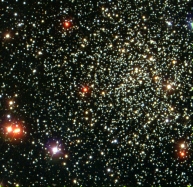 |
NGC 6791
Shown is the open cluster NGC 6791, located in the constellation Lyra (part of the Summer triangle). This particular cluster is useful as a strong observational test of stellar evolution theory, since it is one of the oldest open clusters around, with an age about twice that of our Sun. Most open clusters are shredded by the gravitational pull of the Milky Way, or encounters with other massive objects, such as giant molecular clouds. Fortunately, NGC 6791 has avoided this fate and has an important spot in the observer's toolbox.
|
 |
Seyfert's Sextet
Shown is the galaxy group known as Seyfert's Sextet. This group is found in the constellation Serpens. Actually, there are only five main galaxies in this images and only four are interacting. The face-on spiral that is in the "ring" of galaxies is actually a background object. The wispy feature on the upper left is probably the remnant tidal tail of a past interaction, now just a loosely bound collection of gas and stars. The remaining four galaxies are densely packed and undergoing strong gravitational interactions. The public can now help examine the menagerie of galaxies observed by SDSS at galaxyzoo.org (link available in the Education page).
|
 |
2007 WD5
Shown is the asteroid 2007 WD5, which was imaged by the SDSS telescope on Nov. 8th. This asteroid is special, because on January 30th, 2008, there is a 4% chance that it will impact Mars. Before this SDSS observation was used, there was only about a 1% chance of this impact. More measurements of the position of this asteroid are needed to measure its exact motion, in order to know if it will impact Mars. If the asteroid does hit Mars, it will probably leave a crater about a kilometer in size.
|
 |
Planetary Nebula G164.8+31.1
Shown above is the planetary nebula G164.8+31.1, with its strange name being derived from its position on the sky. Planetary nebula is a misnomer, as these complexes of gas have little to do with actual planets. They are the last evolutionary steps of stars similar to the Sun, and the circular gas shell you see in green and blue is actually the outer layers of a solar-type star, whose core is now the bluish white star at the center of the image. This remnant core is known as a white dwarf, and contains about sixth tenths of the mass of the Sun, but is only the size of the Earth.
|
 |
NGC 2158
NGC 2158, an open cluster that neighbors Messier 35, is shown above. NGC 2158 is fairly old, and most of its younger stars have evolved off the main sequence, and older, yellow stars now compose the majority of this cluster. It is a few billion years old, and like many open clusters, serves as an important test of stellar evolution models.
|
 |
Cygnus HII region
The Cygnus region, shown above, is an area on the sky that is rich in gas, dust and stars. The green nebulosity above is due mostly to the H alpha transition, and would appear red to the naked eye. The dark columns running through the nebula are dense regions of dust and molecular gas, and they obscure the light being emitted by the gas. This is the same process seen in the more famous Horsehead Nebula in Orion.
|
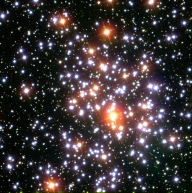 |
Messier 37
Shown above is the open cluster, Messier 37. Located about 4,000 light years away, this group of stars is in the constellation Auriga. It is also among the older known open clusters known, and some of the brighter red stars in this image are evolved stars known as red giants. The numerous bluer stars are less massive stars that are still on the main sequence.
|
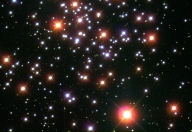 |
Messier 67
Shown above is the open cluster known as Messier 67. Open clusters are groups of stars that have no ongoing star formation, but are loosely gravitationally bound to each other. M67 is one of the older open clusters known, with an age slightly older than our own Sun. Clusters are useful astronomical laboratory since all of the stars are the same age and about the same distance from us, eliminating some of the issues when studying stars spread over the sky.
|
 |
NGC 3338
Shown is the spiral galaxy, NGC 3338. This spiral galaxy is known as a grand design spiral, which describes the sweeping arms that are a dominant characteristic of these types of spirals. Like most spirals, star formation is now occurring in the arms, with older stars providing the yellowish light emanating from the galaxy's core. Explaining the global properties of galaxies, like color, is a complicated problem that includes stellar evolution, star formation and galactic environment, and is an active area of research for today's astronomers.
|
 |
NGC 6058
Shown is the planetary nebula, NGC 6058. Like most planetary nebulae, this object is the death-throes of star like our own Sun. As solar-type stars reach the end of their lifetimes, they begin to push off their outer layers, which are seen in this image as blue. This layer is mostly hydrogen and helium, and is excited by radiation being emitted by the remnant of the stellar core, known as a white dwarf.
|
 |
Meteor Trail
While the SDSS camera does a great job at scanning the stars and galaxies of the Cosmos, it runs into problems when it tries to image moving objects, such as the meteor trail shown above. Meteors are the result of small particles around the size of pebbles entering the Earth's atmosphere and burning up due to the large frictional forces by it. Meteor showers, such as this summer's Perseids, occur when the Earth's orbit intersects debris left by a comet (in the Perseids case, it is Comet Swift-Tuttle), resulting in a proliferation of meteors.
|
 |
Arp 335
The galaxy shown above is Arp 335, also known as NGC 3509. This spiral galaxy is peculiar in that it is dominated by one large arm, probably formed in a collision with another galaxy. Like most galaxies, Arp 335 shows the effects of a gravitational interaction. These types of interactions are actively being explored by observers and theorists, as they play a large role in explaining why the galaxies we see today look the way they do.
|
 |
Messier 2
Shown is the halo globular cluster, Messier 2, in Aquarius. This was originally cataloged by Jean-Dominique Maraldi, and later re-discovered by Messier. Like many of the Messier objects, M2 is visible in small telescopes (or by the naked eye in dark skies). Globular clusters have been a observational workhorse in Astronomy, testing stellar evolutionary models, being used to determine the center of the Milky Way and determining the age of the Galaxy, among other important roles.
|
 |
Perseus Cluster
Shown is a mosaic of the Perseus Galaxy cluster. Similar to other large galaxy clusters, this cluster contains mostly old, elliptical galaxies. Their yellowish hue is primarily due to older stellar populations, such as red giants. The kinematics of these clusters are dominated by dark matter, which is detected by X-ray emission from intracluster gas. The net effect of this dark matter causes the galaxies in this cluster to move faster than if their luminous matter was causing their motions.
|
 |
Messier 13
Shown is one of the more prominent globular clusters in the Northern night sky, Messier 13, in Hercules. This cluster is one of the brightest clusters, and is often one of the first stops for a beginning observer. Visible in the summer sky, this cluster is about 6 visual magnitudes, and will be barely visible with the naked eye from dark skies. M13 was also one of the first targets for potential contact with other civilizations, as it was beamed a radio message from the Arecibo Observatory in 1974.
|
 |
Palomar 5
This unassuming cluster of stars centered in the above image led to one of the many exciting results from early SDSS observations. Palomar 5, a halo globular cluster, is being shredded apart by the gravitational pull of the Milky Way. Thus, the cluster contains relatively few stars in its core, with more mass actually being distributed in tidal tails. These tails are streams of stars being pulled off Palomar 5 along its orbit, and provide an active example of a mechanism that is suspected to play an important role in the evolution of our Galaxy.
|
 |
Coma Cluster
The mosaic image above shows the Coma Cluster, a prototypical dense galaxy cluster. The Coma cluster contains mostly elliptical galaxies, which appear as white-yellow blobs in this image. In fact, most of the blobs in this image are galaxies. This cluster has been studied extensively, both observationally and computationally, as large super-computer simulations attempt to recreate the general properties of this cluster.
|
 |
NGC 5033
Within the heart of the majestic spiral galaxy shown above, NGC 5033, lies a powerful engine. This galaxy is one of the most commonly studied Seyfert galaxies. Seyfert galaxies are a class of active galactic nuclei (AGN). In particular, Seyferts produce large amounts of emission line spectra in their core, often with variable power. The driving source of this emission is thought to be a supermassive black hole, with a mass of at least 10 million solar masses.
|
 |
NGC 1491
Shown is the nebula NGC 1491, located in the constellation Perseus. This nebula is being actively shaped by the bright star located to left of center in this image. The star is ionizing the surrounding hydrogen gas, resulting in a reddish color tint to the nebula. One can also see the bubble being cleared out by the star as it blows out its local surroundings.
|
 |
NGC 2264
The swirling gas and dark dust lanes of the nebula NGC 2264 is shown above. The light being produced in this image has two sources. First, the bright stars in the image are ionizing nearby hydrogen gas, which re-emits light as it cools back down. Additionally, the gas and dust scatters some of the starlight, in much the same way the Earth's atmosphere scatters blue light, producing our blue skies.
|
 |
Messier 3
Shown is the globular cluster, M3. One of the few hundred globular clusters in our Galaxy, this cluster is composed of mostly old, evolved stars. Globular clusters are among the oldest objects in the Galaxy, forming when the Milky Way was young. First cataloged by Messier in 1764, this cluster contains hundreds of thousands of stars and is visible to the naked eye under dark skies.
|
 |
Cocoon Nebula
The green, gaseous nebula shown here is the H II region, IC 5146, also known as the Cocoon Nebula. The 'II' in H II indicates that the hydrogen gas that enshrouds these young stars is ionized, which is the result of the hot, young stars that are scattered throughout the nebula. These stars have formed recently, and are starting to burn away the cooler gas that condensed to form them. The color scheme used here is the result of the SDSS filter set and data software. Hence, gas that is usually red in other images appears green here.
|
 |
NGC 3786 and NGC 3788
Shown above are the spiral galaxies NGC 3788 (top) and NGC 3786 (bottom) in the constellation Ursa Major (home of the Big Dipper). These two galaxies, like many found throughout the SDSS survey, are gravitationally interacting. Interactions such as these are commonly observed by the SDSS. They are thought to lead to the formation of elliptical galaxies, and it will probably be the fate of the Milky Way and M31 in the distant future.
|
 |
NGC 5701
NGC 5701, located in the constellation Virgo, is a classic example of a barred spiral galaxy. The yellow bulge, composed of older stars, has a distinct bar running vertically in this image. At larger distances from the center of this galaxy, bluer spiral arms wrap around, which is an indication of recent star formation. The formation of bars in spiral galaxies is not well understood, and large computer simulations are used to explore how they might come to be.
|
 |
Comet 67P/Churyumov-Gerasimenko
Shown is the Comet 67P/Churyumov-Gerasimenko, as imaged by the SDSS telescope. This short-period comet orbits the Sun every 6.6 years, and it has become the focus of an ambitious space mission, Rosetta, which is being operated by the European Space Agency. This past Sunday, the Rosetta spacecraft performed a gravity-assisted flyby of Mars, using the Red Planet's gravity to slingshot it towards the comet. In 2014, the spacecraft will catch up to the 4 km object, and perform the first controlled landing on one of these icy bodies.
|
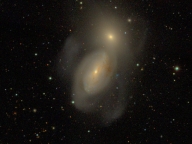 |
NGC 3227
Shown is the galaxy pair NGC 3227 (bottom) and NGC 3226 (top). NGC 3227 is a spiral galaxy, which is interacting with the dwarf elliptical NGC 3226. The spiral galaxy is home to an active galactic nucleus, which is a high-energy source that is thought to be powered by a black hole. As the accretion disk around the black hole is heated, it produces X-rays. Also, as seen in other images of the week, galaxy interactions are common, as most galaxies are found in groups.
|
 |
NGC 1129
Shown is the galaxy cluster, AWM 7, with the dominant elliptical galaxy NGC 1129 at its center. Elliptical galaxies, in contrast to the spiral and irregular galaxies shown in past weeks are composed of mostly older stellar populations. These stars are older than our Sun, moving towards the end of their luminous lives.These galaxies are often found in dense environments, as shown here. Most of the major galaxies in this image are elliptical galaxies, which are thought to be the end product of a merger between spiral galaxies.
|
 |
Arp 188
Shown is Arp 188, better known as the Tadpole galaxy. This relatively nearby galaxy (at a distance of 420 million light years) has undergone a massive interaction in the recent past. This gravitational struggle tore part of the Tadpole free, stripping gas away from the galaxy and touching off a torrent of star formation. The not-so-friendly neighbor is positioned behind the Tadpole, barely discernible at the bottom-right of the galaxy. These type of interactions are common in the Universe, as many galaxies observed with SDSS seem to have undergone an interaction in the past.
|
 |
SDSS AAS Booth
At the recent American Astronomical Society meeting held in Seattle, Washington, astronomers from all over the country gathered to discuss and present the latest in fields ranging from exoplanets to flaring stars to the formation of galaxies. The SDSS has had a broad impact on astronomy, and highlighted some of the major efforts of the collaboration with a booth at the meeting. In this picture,(chef) Jordan Raddick of Johns Hopkins University explains some of the resources available to the public for exploring the SDSS database. Many of these sites are linked from the Education page on the main SDSS webpage.
|
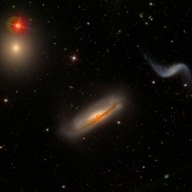 |
Hickson Group 44
This group of three galaxies in the constellation Leo (aka the Trio in Leo) is composed of two spiral galaxies (NGC 3190 at the center of the image, NGC 3187 at the left of the image). The non-descript elliptical galaxy NGC 3193 is located at the left side of the image. These galaxies are members of Hickson Compact Group 44, compiled by Canadian astronomer Paul Hickson. These groups are thought to have interacted in the past (as have most galaxies) and NGC 3190 exhibits some traces of a past interaction with NGC 3187.
|
 |
Comet 2001 RX14 (Linear)
Shown is one of the handful of comets detected in the SDSS footprint, Comet 2001 RX14 (Linear). This hyperbolic comet made one pass around the sun in 2003, and left the solar system, never to return again. This comet reached a peak brightness of about 11, much fainter than Comet McNaught, which is currently dazzling skygazers around the globe. Objects such as Comet RX14 are scattered into the inner solar system from the Oort Cloud, after being jostled by the gravitational tugs of the large, gas giant planets.
|
 |
NGC 3395
Continuing with the theme of interacting spiral galaxies, we present the pair of NGC 3395 and NGC 3396. Found in the constellation Leo Minor, these two sprial galaxies the classic sign of gravitational interactions, elongation in the direction of its partner. Of particular interest are the knots of star formation that show up as turqouise blobs in this SDSS image. The dominant source of light in these regions is thought to be provided by young, massive stars.
|
 |
NGC 4490
This pair of galaxies, known as the Cocoon Galaxy, form an astrophysical laboratory for studying interacting galaxies. These two spiral galaxies (NGC 4490 on the bottom) are being pulled towards each other by gravity, distorting their shapes. The pair has also undergone a recent collision, which touched off a spurt of star formation, as seen in the blue-green bright spots that are seen in both galaxies. The Cocoon Galaxy is located in Canes Venatici, and is easily visible in a six-inch telescope, during the spring.
|
 |
NGC 5905
Shown are two spiral galaxies in Draco, NGC 5905 (right) and NGC 5908. These two galaxies gracefully display the vast range of observational characteristics such as inclination, dust content, and stellar populations. NGC 5905 displays its wide spiral arms, consisting of young, blue stars and hydrogen gas. The bar in the center is composed mostly of older, yellow stars. NGC 5908 is seen edge-on, with a large dust lane absorbing visible light. Again, younger, bluer stars are seen near the outskirts of the galaxy.
This wide-field image also displays a large number of stars in our own Milky Way(another spiral galaxy), mostly populated by cool, red stars.
|
 |
NGC 1055
NGC 1055 is an edge-on spiral galaxy in the constellation Cetus. With its nearby neighbor, M77
(also in Cetus), NGC 1055 forms a binary galaxy pair that is thought to be interacting gravitationally,
much like our own Milky Way and the Andromeda Galaxy. This galaxy is also thought to be undergoing
rapid star formation.
|
 |
NGC 7606
NGC 7606 is a spiral galaxy (Sb) located in the constellation Aquarius. Fairly bright (a visual
magnitude of about 11), NGC 7606 is visible both by the SDSS 2.5m telescope and larger (about 10 inches)
amateur telescopes. Aquarius is visible in the Northern Hemisphere during the fall months.
|
 |
NGC 4214
Bright young star clusters surrounded by wispy filaments of gas comprise
the most striking features of NGC 4214. This irregular galaxy resides 13
million light years away in the constellation Canes Venatici. Winds from
young stars and supernovae have shaped gas clouds into the bubbles seen
near the bright core and filaments throughout. Clusters of varying age
imply an active star-forming past as well as present in NGC 4214.
|
 |
NGC 4449
NGC 4449 is an irregular galaxy similar in size and morphology to our close
neighbor to the south, the Large Magellanic Cloud. Residing in the
constellation Canes Venatici, NGC 4449 has bright clouds of ionized
hydrogen seen near the bottom of the image. Within these clouds of
hydrogen are regions of on-going star formation.
|
 |
Messier 101
The Pinwheel Galaxy, also known as Messier 101 and NGC 5457, is a face-on
spiral in the constellation Ursa Major. Though M101 extends over 22 arc
minutes in the sky, only the central region of this Sc type galaxy is
visible here. Its spiral arms are marked with clumps of bright young
stars and dark dust lanes.
|
 |
NGC 4656
NGC 4656 is a peculiar spiral galaxy in Canes Venatici. Dubbed the Hockey
Stick, this galaxy has been disturbed by neighboring NGC 4631. A tenuous
bridge of hydrogen gas connecting the two, visible at the 21cm
wavelength, provides evidence for the interaction. In this image knots of
star forming regions are visible on the warped side.
|
 |
NGC 4636
NGC 4636 is an elliptical galaxy about 50 million light years away in the
constellation Virgo. Though it looks normal viewed here in the visible,
in X-ray wavelengths NGC 4636 shows an extended halo of hot gas
with pronounced arcs that extend out 25,000 light years from the center.
These structures, which are unusual for an elliptical galaxy, may trace
the leading edge of a galaxy-sized shock wave resulting from a titanic
explosion in the core three million years ago.
|
 |
NGC 2903
In the constellation Leo resides NGC 2903, a barred spiral galaxy.
Infrared observations have revealed that star formation in this galaxy is
occurring in a ring around the center. Hubble Space Telescope images of NGC
2903 found that the strange hot spots near the galaxy's center are
actually bright young globular clusters, a striking contrast to the
uniformly old globular clusters in our own galaxy.
|
 |
Stephen's Quintet
This picturesque grouping of galaxies, known as Stephen's Quintet, is
found in the constellation Pegasus. Of the five galaxies in Stephen's
Quintet, four are involved in a massive collision (the spiral galaxy at
the bottom is a foreground object). Earlier this year, Spitzer Space
Telescope observations of this group found one of the biggest shock waves
ever seen. NGC7318b, the right of the two small bright regions in the
center of the image, is colliding with the hydrogen gas spread throughout
the cluster.
|
 |
Asteroid
How does an asteroid appear in the Sloan Digital Sky Survey? This asteroid
moved a significant amount during the five minutes that it took to make
this image causing the red, green and blue streaks pictured here. Since
each patch of sky is imaged in five filters in succesion, a moving object
shows up in different locations in each of the different filters. Only three
of the five filters are used to make this image, giving rise to the three
colored streaks.
Asteroids were in the public eye this week as astronomers at the 2006
International Astronomical Union meeting for the first time defined what
is a planet. Though near-Earth asteroids like the one pictured here are
typically very small, other larger bodies in the asteroid belt may soon be
upgraded from asteroid to dwarf planet.
|
 |
Messier 81
Messier 81 is a gorgeous spiral galaxy 12 million light years away in the
constellation Ursa Major. The distance to M81 is one of the best
determined for a galaxy. This measurement was done using Cepheid
variables, stars that vary in brightness as they pulse in size over a
period of days. The absolute brightness of these stars is directly
correlated with their pulse period. By measuring the apparent brightness
and pulse periods of 30 Cepheids in M81 astronomers were able to calculate
the distance to this galaxy.
|
 |
NGC 4699
NGC 4699 is a tightly wound spiral galaxy 60 million light years away near
the edge of the Virgo Cluster. Inside the very bright core is a hint of bar
structure. In 1983, this galaxy was host to a type II supernova that, for
the first time ever, was observed with high quality spectra before it
reached maximum brightness. This gave astronomers new insights into the
nature of the progenitors of this type of supernova, massive stars at the
end of their lives.
|
 |
Hickson 88
Starting at the bottom of the image and going up are NGC 6975, 6976, 6977
and 6978, the compact group of galaxies known as HCG 88. The lower two are
type Sbc galaxies while NGC 6978 (top) is a more tightly wound Sb. NGC
6977 is a barred spiral SBb, just like our own galaxy. These four, which
reside in the constellation Aquarius, show no signs of previous or current
interactions. In the left-most three you can see the rate of star
formation neatly increase as you go up.
|
 |
NGC 4568
The Siamese twins, NGC 4567 and NGC 4568, look like they are in the
middle of a collision. But yet these two members of the Virgo Cluster
show none of the usual signs of interaction such as tidal tails or
distortion. It may be that one is just passing in front of the other.
|
 |
NGC 6384
In the constellation Ophiucus resides NGC 6384, a spiral galaxy with a
central bar structure and a possible central ring. Because NGC 6384 is
nearly in line with the plane of our galaxy, all the stars in the image
are foreground stars in our Milky Way.
|
 |
GL Tauri
Adding to its collection of planetary nebulae, the Sloan Digital Sky
Survey recently imaged this object: H 3-29. At the center is GL Tauri, a
variable star that has blown off an expanding cloud gas seen here as the
blue-green haze around the star. Planetary nebulae are short-lived
objects, lasting only a few thousand years, which makes them rare.
This image courtesy of Doug Finkbeiner.
|
 |
NGC 5257 and 5258
Galaxies lead very active lives. In this image NGC 5257 and 5258,
two spiral galaxies in the constellation Virgo, are seen in the midst of a
collision that has taken on the order of a billion years. As a result, a dim
bridge of stars is now stretched between them and both are actively
forming new stars in their disks. The shapes of galaxies after a collision
depend on the collision geometry and the masses of the galaxies.
Chris Mihos of Case Western Reserve University, together with colleagues
at the University of Oregon, has created a java applet that lets you crash
galaxies together. Try different collision geometries and masses to see if
you can reproduce the collision seen in this image.
http://burro.astr.cwru.edu/JavaLab/GalCrashWeb/GCSolo.html
|
 |
NGC 5162
The fifth data release (DR5) from the Sloan Digital Sky Survey is available
to the public starting today. The survey's database now contains imaging for
215 million unique objects including this one, NGC 5162. With its many
spiral arms and a bar structure in the center, NGC 5162 resides in the
constellation Virgo.
|
 |
NGC 5585
NGC 5585 is a "flocculent" galaxy in Ursa Major. Galaxies of this type have
the disk shape of a spiral but instead of well-defined arms, their brightest
stars are in a fluffier, more stochastic arrangement. NGC 5585's
appearance may be the result of interactions with other galaxies in the
M101 group.
|
 |
NGC 3184
With its striking spiral arms, NGC 3184 is a face-on galaxy in the
constellation Ursa Major. In 1999 this galaxy was host to a supernova
which originated in one of its star-forming regions. In SDSS images,
star-forming regions show up as blue-green in color and as you can see
from the image, this galaxy contains a wealth of them. As a result of active
star formation, NGC 3184 is also known for its high abundance of heavy
elements.
|
 |
NGC 3521
Spiral galaxy NGC 3521 is often overlooked in favor of the nearby Leo
triplet. But if you're an amateur astronomer with a telescope, this
lovely galaxy is worth the hunt. At a magnitude of 8.9, it has a bright
concentration in the middle and a dark band of dust blocking light from
the near side. As you can see in this image, NGC 3521 also displays a
magnificent halo of matter ejected from the disk.
|
 |
Messier 102
The most contended of the original Messier objects, M102 was considered
"missing" for a long time due to an error in its recorded position. In a
rush to publish, Charles Messier did not double check the positions of
his last three Messier objects: M101, M102 and M103. For a while M102 was
thought to be a duplicate entry for M101 but it is now thought to be this
object, an edge-on spiral galaxy between the stars Omicron Bootis and
Iota Draconis.
|
 |
Messier 78
M78 (also known as NGC 2068) is a reflection nebula in the Orion
constellation. Hot young stars in the nebula's center illuminate the
surrounding gas. Further out, dark clouds of dust prevent much of the
scattered light from reaching us, creating a complex pattern of light and
shadow. This star-forming region is only about 100,000 years old.
|
 |
Messier 97
The Owl Nebula (M97) is the spectacular remains of a sun-like star at the
end of its life. The parent star, buried in the center of this expanding
cloud of gas, exhausted its fuel for fusion several thousand years ago.
When this happened, the star collapsed to form a white dwarf and shed its
outer layers to create the nebula pictured here. Planetary nebulae do not
last forever -- as this shell of gas expands it will eventually become too
thin to see.
|
 |
Two new Milky Way companion galaxies
Meet the new neighbors! Two new dwarf galaxies, one in the constellation
Bootes (left) and one in Canes Venatici (right), were recently discovered
in the SDSS-II data. Though they are right in our cosmic backyard --
190,000 and 640,000 lights years away respectively -- the newly discovered
dwarf galaxies are extremely dim, making them hard to spot. These two put
the total number of companion galaxies to our Milky Way at ten. But with
the SDSS-II SEGUE project probing the Milky Way's structure in
unprecedented detail more dwarfs are sure to turn up. (Image credit:
Vasily Belokurov, SDSS-II collaboration)
|
 |
Messier 31
M31, better known as the Andromeda galaxy, is our nearest spiral neighbor.
Visible to the naked eye on a clear moonless night, M31 appears nearly
three degrees wide in our sky -- that's six times the width of the full
moon! Because of M31's large angular size, this picture was created by
stitching together data from multiple SDSS images. A new dwarf spheroidal
galaxy was recently discovered in M31 using SDSS photometry data and
follow-up observations. This puts the count at 10 known satellite galaxies
contained within M31.
|
 |
Messier 51
Messier 51, nicknamed the Whirlpool Galaxy, is the classic spiral. Its
dusty arms sweep in front of the smaller galaxy to the left, well behind
M51. This Sc-type galaxy shows a heavy amount of star formation sparked by
its interaction with the smaller galaxy. This pair make a good observing
challenge for amateur astronomers with dark skies and a modest telescope.
Look for it just below the tip the Big Dipper's handle, in the nearby
constellation of Canes Venatici.
|
 |
Abell 2151
The Hercules Galaxy Cluster - a cosmic Easter Egg hunt! How many galaxies
can you find? This cluster, about 650 million light years away in the
constellation Hercules, is rich in spiral galaxies. See if you can find
three pairs of colliding spiral galaxies. For a harder challenge, try to
spot the foreground stars which reside in our own galaxy. This cluster of
galaxies is a part of the Hercules supercluster which is a part of the
Great Wall, a gigantic chain of galaxy clusters that is half a billion light
years long.
|
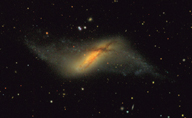 |
NGC 660
NGC 660 is a polar ring galaxy in the constellation Pisces. The galaxy
itself is seen edge-on from our part of the universe but the faint ring
surrounding NGC 660 is seen at an angle. This ring around the galaxy was
likely the product of a violent collision with another galaxy in the past,
one which has sparked a burst of star formation at NGC 660's core.
|
 |
Messier 77
Late March marks a special time of year when ambitious astronomers in North
America can look at all 110 of the Messier objects in a single night.
This year, the weekends of March 25/26 and April 1/2 were the best weekends
for attempting the Messier marathon. If you were going in
order then you would have encountered this object, M77, early in the
night. M77, also known as NGC 1068, is a spiral galaxy in the constellation
Cetus. It is the nearest and brightest example of a Seyfert II galaxy.
|
 |
NGC 5394 and NGC 5395
NGC 5394 and NGC 5395 - shall we waltz? Frequent turns around the
cosmic dance floor have given these galaxies many of their most
interesting features. NGC 5395 (the larger of the two main galaxies shown)
boasts dark lanes and knotted spiral arms in the visible wavelengths and a
long tidal tail seen in radio. NGC 5394 has both inner and outer spiral
arms and a burst of star formation near its center. Radio studies of this
pair show that they are headed for another collision millions of years
from now as gravity swings them closer together.
|
 |
NGC 2549
NGC 2549 is an example of a lenticular galaxy, seen nearly
edge-on. Lenticular galaxies are disk galaxies without visible spiral
structure, and get their name because they often resemble a lens seen
edge-on. In the Hubble classification, they are regarded as an
intermediate between spiral and elliptical galaxies. Three structural
components frequently seen in galaxies are pronounced in this image: a
bright central disk, a bright central envelope, and a faint extended
envelope. Several smaller galaxies can be seen in this image; such
companion galaxies are common around large galaxies.
|
 |
Messier 98
Messier 98 is another spiral galaxy in the Virgo Cluster. The
velocity at which an astronomical object is moving toward or away from
us can usually be accurately measured, because this motion causes the
light from it to appear more red (if it is moving away from us) or blue
(if it is moving toward us) that it would if it were not moving. Most
galaxies are found to be moving away from us due to the expansion of
the universe. This expansion, however, is not the only factor in
determining the velocity of a galaxy; it may, for example, be falling
toward other galaxies, or clusters of galaxies, and so there are a few
cases where the galaxy is actually moving toward us. Messier 98 is
one of these cases.
|
 |
Messier 104
Messier 104, nicknamed the Sombrero Galaxy, is an unusual spiral
galaxy with both a large central bulge and a prominent, dusky disk,
which we see nearly edge-on. A large system of globular clusters
resides in this galaxy. These clusters appear as star-like point
sources because they are so far away. Messier 104 was also the origin
of several important historical discoveries: it was the first galaxy
in which dust lanes were seen, and also the first in which rotation
was detected.
|
 |
Messier 94
Messier 94, nicknamed the Croc's Eye Galaxy, is another face-on spiral
galaxy with an unusual star forming pattern. The center itself is very
bright, and it is surrounded by a blue ring of recently formed stars.
Spiral arms and dust lanes extend from the center well past the ring.
A second, very faint ring can be seen surrounding the galaxy, just barely
visible in this image.
|
 |
Messier 76
Messier 76, nicknamed the "Little Dumbbell Nebula" in reference to the
Dumbbell Nebulae (Messier 27), is roughly the same size as its more famous
namesake. It is, however, about five times as far away, and therefore
appears much smaller. Planetary nebulae are so named because some of
them have a disk-like appearance, similar to the appearance of a planet
in a telescope. They are, however, not related to planets at all, but
instead are clouds of gas expelled by a star near the end of its life,
and illuminated by that star.
|
 |
Leo I
Dwarf spheroidal galaxy Leo I is the most distant of several smaller
companions of the milky way. It was first discovered in the SDSS's
predecessor, the Palomar Observatory Sky Survey.
|
 |
NGC 4478
Elliptical galaxy NGC 4478 is a close companion of Messier 87, and
like other galaxies featured here, NGC 4478 is has been disturbed by
its larger neighbor. In this case, however, the disturbance is more
subtle. The light from most elliptical galaxies decreases smoothly as
one looks further and further from the center of the galaxy, and faint
light from a these galaxies can usually be seen extending far from the
center. In the case of NGC 4478, however, the light decreases smoothly
for a while, and then drops abruptly. Interaction with Messier 87 has
probably removed the matter that would have made up the outer regions
of this galaxy.
|
 |
Messier 88
Messier 88 is one of the more prominent spiral galaxies in the Virgo
Cluster, a large collection of galaxies seen in the direction of the
constellations Virgo and Coma Bernices.
|
 |
UGC 4261
The irregular galaxy UGC 4261 is clearly dynamically disturbed,
possibly forming a polar ring, and possibly featuring a jet.
|
 |
NGC 3631
NGC 3631 is another example of a "grand design" spiral galaxy seen
nearly face on. Two long, pronounced spiral arms, both with active
star formation, extend from close to the center out to the edges of
the galaxy. NGC 3631 is an ScII type galaxy according to its Hubble
classification and van den Bergh luminosity class: the S designates
that it is a spiral, the "c" that the arms are loosely wound, and the
"II" that it is moderately bright.
|
 |
NGC 3626
NGC 3626 is a spiral galaxy with a striking dust lane encircling its
central bulge. This galaxy is unusual in that the gas in the galaxy
rotates counter to the rotation of the stars. How this situation
occurred is unclear; one speculation is that the galaxy itself
recently merged with a large cloud of gas.
|
 |
NGC 5964
NGC 4964 is an impressive face on spiral galaxy with many
broken spiral arms. The colors of the different parts of the galaxy
show differences in star formation history: the reddish color of
the central bulge indicates that it is older than the disk, while the
blue spots in the disk, particularly in the arms, show where new star
formation is taking place. This pattern is typical of spiral galaxies.
|
 |
Messier 109
Messier 109 is a typical barred spiral, found in the Ursa Major
cluster of galaxies. The beginnings of the spiral arms are offset
slightly from the ends of the bar.
|
 |
NGC 4643
NGC 4643 lives in the Virgo cluster, a relatively nearby cluster of
galaxies, well studied because of it proximity. NGC 4643 is a disk
galaxy with a pronounced bar and only a hint of spiral arms, near the
ends of the bar.
|
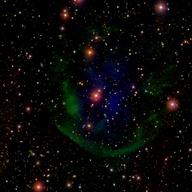 |
IRAS 08515+0905
IRAS 08515+0905 is an example of a planetary nebula. Planetary nebulae
are clouds gas recently ejected from a dieing star, and illuminated by
ultraviolet light from the star's remains.
|
 |
Messier 66
Messier 66 is one member of the Leo Triplet; the other members are
Messier 65 and NGC 3628. Interactions with these other members caused
the asymmetric, disturbed appearance of this galaxy. Dust lanes in the
galaxy appear as dark bands running along the arms and elsewhere.
|
 |
SDSS Imaging Camera
The SDSS imaging camera collects data using array of 30 CCD's arranged
in six columns. Each of the five rows collects data through a different
filter. An additional 24 CCD's are arranged before and after these to
measure the positions of bright stars, allowing more precise
determination of the telescope pointing.
|
 |
Messier 95
Messier 95 is a typical example of a barred spiral galaxy. Spiral
arms that appear to begin at the ends of the bar initially form a
tight ring before extending outward. Studies of variable stars in M95,
as measured in images taken by the Hubble Space Telescope, play an
important role in determining the distance scale.
|
 |
Messier 60
M60 is a typical giant elliptical galaxy with a spiral galaxy,
NGC 4674, nearby. The difference in color between the two is the
result of different star formation histories, and the color of each is
typical of their type.
|
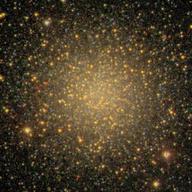 |
NGC 2419
NGC 2419 is the most distant globular cluster that can arguably
associated with the Milky Way galaxy, even further than the Magellanic
clouds. Because its association with the Milky Way (or any other
galaxy) is so weak, it has been nicknamed the "Intergalactic
Wanderer."
|
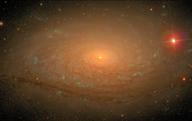 |
Messier 63
Messier 63, nicknamed the "Sunflower Galaxy," is a spiral galaxy with
a complex structure of dust lanes and star forming regions, which
appear as blue-green knots in this image.
|
 |
NGC 3310
NGC 3310 is a spiral galaxy with plenty of active star formation
surrounded by much fainter structures. The linear structure (perhaps a jet)
running from the center to the lower right of this image, together
with the faint arc it crosses, have resulted in NGC 3310 being called
the "bow and arrow" galaxy.
|
 |
NGC 3104
NGC 3104, also known as Arp 264, is an irregular galaxy with many
knots embedded in a faint envelope. It is a member of the Arp catalog,
a collection of astronomical objects with unusual appearances. Members
of this catalog often find their way into collections of images to
provide variety or illustrate unusual phenomena.
|
 |
NGC 4244
NGC 4244 is a nearby, edge-on disk galaxy. It is close enough that
individual stars can be detected and measured, which allows
astronomers to use stellar properties to estimate the distance. There
appears to be little or no central bulge, and only a few star forming
regions are visible; there is little active star formation.
|
 |
NGC 5005
NGC 5005 is an example of a Seyfert 2 galaxy. Seyfert galaxies typically
have exceptionally bright, compact nuclei; the nucleus of NGC 5005 is
saturated in this image. The light from the nucleus features strong emission
lines, which cannot be accounted for by starlight.
|
 |
NGC 5053
NGC 5053 is one of the sparsest globular clusters known, and when originally
discovered there was some uncertainty whether it was a large open cluster.
The color-magnitude diagram, a plot which relates the colors of stars to their
brightness, confirms that NGC 5053 is indeed a globular cluster.
|
 |
NGC 2420
NGC 2420 is one of the few open clusters observed in the original
SDSS survey. Most open clusters reside in the disk of the milky way,
because that is where there is the most material for new star
formation. The coverage of the original SDSS avoided this area,
however, so that data on extragalactic sources could be collected with
minimal obstruction from material in our own galaxy. We have recently
begun data collection for the SDSS-II survey, which will extend the
survey coverage into the milky way.
|
 |
NGC 5919
NGC 5919 is a member of a galaxy cluster Abel 2063, and several other
members are visible in this image.
|
 |
NGC 2537
Because of its unusual shape, featuring a partial ring containing
several bright star forming regions, NGC 2537 is sometimes called the
"Bear Paw." NGC 2537 is a dwarf irregular galaxy, perhaps the most
common type of galaxy.
|
 |
NGC 5466
Although relatively sparse compared to other globular clusters, NGC 5466
still shows the strong central concentration, spherical shape, and
greater size that distinguish globular clusters from open
clusters. Globular clusters are the oldest known structures in our
galaxy, and globular cluster studies provide essential data for
studying how stars age.
|
 |
NGC 5474
The asymmetric dwarf spiral galaxy probably got its peculiar shape
from an interaction with the nearby galaxy M101. The blue knots
indicate new star formation, probably triggered by the same
interaction.
|
 |
CGCG 180-023
CGCG 180-023, also called II Hz 4, is a superb example of a ring
galaxy. Ring galaxies are believed to form when a compact smaller
galaxy plunges through the center of a larger more diffuse rotating
disk galaxy. The galaxy in transit exerts a brief inward pull on the
stars of the target galaxy, which execute radial harmonic oscillations
in addition to their initial circular motion. A series of ring waves
forms and propagates through the target disk, as numerical simulations
have convincingly demonstrated (e.g., Lynds & Toomre 1976; Theys &
Spiegel 1977). These radially expanding waves are accompanied by a
strong burst of star formation: observed ring galaxies are usually
very blue and possess large HII regions (Theys & Spiegel 1976; Jeske
1986).
|
 |
NGC 3239
This object is a relatively nearby galaxy in the constellation Leo.
It unclear why it has such an irregular appearance. It might be a
superposition of two galaxies the are close to each other or perhaps
colliding.
|
 |
Palomar 14
Palomar 14 is a faint globular cluster discovered in the Palomar
Observatory Sky Survey (POSS), an earlier generation of sky
survey composed of photographic plates. Palomar 14 is a relatively
young globular cluster, and one of the most distant in our galaxy.
|
 |
NGC 4631
NGC 4631, also called the Whale Galaxy because of its shape, is an
excellent example of an edge on disk galaxy being disturbed through
interactions with multiple other galaxies. Disruptions caused the
the asymmetric, whale-like appearance and probably contributed to
the significant star formation seen as blue knots in this image.
|
 |
3C 273
3C273 was the first discovered, brightest, and probably most studied
quasar. Quasars are the active nuclei of galaxies, bright enough to be
seen even when the host galaxy is too faint. Because of this, they
generally look like stars in images. Like other active galactic
nuclei such as that of M87, quasars often have associated jets; the
jet of 3C273 can be seen clearly in this image.
|
 |
NGC 4725
The bar in NGC 4725 barred galaxy is relatively faint, and this galaxy
is therefore sometimes considered a borderline object between barred
and unbarred spirals. The bright blue spots in the spiral arms
indicate new star formation, because blue stars only live a short
time; in areas where there are only older stars, the blue stars have
already all died, and the galaxy appears more yellow. Dust lanes can
be seen against the background of the central bulge, and indicates
which is the near side of this galaxy.
|
 |
NGC 4565
The striking dust lanes are the most prominent feature of this disk
galaxy, seen nearly edge on. The disk appears to be slightly warped at
the far edges, a feature that is more pronounced in radio images.
NGC 4565 has a clear bulge, but little light can be seen in from its
halo.
|
 |
62P/Tsuchinshan
Comets are traditionally named after their discoverers. Comet
62P/Tsuchinshan is named after Purple Mountain observatory, at which
it was discovered. The 62P designation identifies it as a short
period comet. Periodic comets have elliptical orbits, which fade
from view and then reappear as their orbits take them closer and
further from the sun. 62P/Tsuchinshan has a relatively short period of
roughly 7 years; other periodic comets have much longer periods of
hundreds of years.
|
 |
NGC 5248
NGC 5248 is a spiral galaxy, inclined slightly. Star formation regions
appear as blue spots in the spiral arms. There is also evidence for
star formation near the nucleus.
|
 |
NGC 3737
The bright galaxy near the center of this image is NGC 3737. The
redshifts of NGC 3737 and the other galaxies in this field indicate
that some of the other galaxies have redshifts similar to that of NGC
3737, and are therefore genuine neighbors, while others are much
further away.
|
 |
Messier 87
Messier 87 is a giant elliptical galaxy with several distinctive
features. Found near the center of the the largest component of the
Virgo cluster of galaxies, it is also one of its largest
members. Several companion galaxies are evident, as is a large
population of globular clusters. These clusters make the galaxy appear
covered in glowing freckles.
M87 has a prominent jet (pointing slightly right of down in this
image) and an active nucleus, thought to contain a massive black
hole.
|
 |
Messier 64
The spiral galaxy M64 appears highly inclined, but not edge on. The
prominent dust lanes have earned it a nickname: "The Black Eye
Galaxy."
|
 |
NGC 7814
NGC 7814 is a disk galaxy seen edge on. From this angle, we cannot
determine whether it has a spiral structure. This image shows clearly
the dust in its disk and its bright central bulge. The brightest
globular clusters associated with NGC 7814 can also be seen; they
appear as point sources near the galaxy.
|
 |
IZw18
Because blue stars have short lifetimes, the blue color of this galaxy
indicates that most of the light from this galaxy is from recently
formed stars. Spectra of IZw18 show few heavy elements, providing
additional evidence that the stars in this galaxy are young; older
stars would have generated more heavy elements. It has therefore been
heavily studied to improve our understanding of star formation in
primordial conditions.
|
 |
VIRGOHI21
Radio telescopes at Arecibo and Jodrell Bank Observatory detect a
large cloud of hydrogen gas at the center of the region of the sky
covered by this image, but no corresponding objects can be seen in
it. The rotation of this cloud indicates the presence of a significant
mass of dark matter (matter that we cannot currently detect directly)
as well.
|
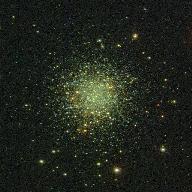 |
NGC 288
This image of the globular cluster NGC 288 came from the SDSS
photometric telescope. Globular clusters are centrally concentrated
spherical collections of stars, typically numbering in the hundreds of
thousands. Note that NGC 288 contains stars with a variety of colors
and luminosities. Because the stars in a globular cluster are formed
at the same time, from the same cloud of gas, and are at the same
distance, these differences are not due to age, initial composition,
or distance, but mass.
|
 |
NGC 4438 and NGC 4435
NGC 4438 (upper left) and NGC 4435 (lower right) are two members of the
Virgo cluster of galaxies. The blue filaments extending from NGC 4438
indicate disruption from recent interaction with another galaxy. The
obvious candidate is NGC 4435, but spectroscopic observations indicate
that these two galaxies may be moving past each other too quickly too
have such a strong interaction; NGC 4486 (M87) is another good
candidate for the disrupting influence.
|
 |
NGC 1491
This object is an HII region in the constellation Perseus. The
colored image is constructed from three separate images taken with
ultraviolet, green, and red filters. The light is emitted by a hot,
rarefied plasma of gas that is being excited by embedded hot stars.
The reddish light is emitted by a combination of hydrogen and
nitrogen; the yellowish light is emitted by a combination of oxygen
and other elements. Dust is mixed in with the glas, creating
silhouette patterns throughout the neubla.
|
 |
Messier 44
Messier 44, also know as Praesepe and the beehive clusters, is a famous cluster
of stars in our own Milky Way galaxy. It is at a distance of about 180
parsecs in the constellation Cancer. The stars all formed at nearly the
same time, about 800 million years ago. The cluster includes many different
types of stars, including main sequence stars, red giants, and white dwarfs,
and is often studied by astronomers.
The Messier catalog was compiled by Charles Messier as an aid in finding
comets - most of the objects in his catalog are faint and nebulous in
appearance and easily mistaken for comets. It is unclear why he included
this star cluster as object 44 since it is bright and was already well known.
|
 |
NGC 2403
This splendid spiral galaxy is located in the constellation
Camelopardus (the Giraffe). It is a member of a group of galaxies that also
includes Messier 81 and Messier 82. Galaxies come in a wide range of sizes;
NGC 2403 is about in the middle of the pack. It has no central bulge to
speak of, but does exhibit a large number of HII regions (the knots
sprinkled throughout the spiral arms) and several small lanes of dust.
|


























































































































